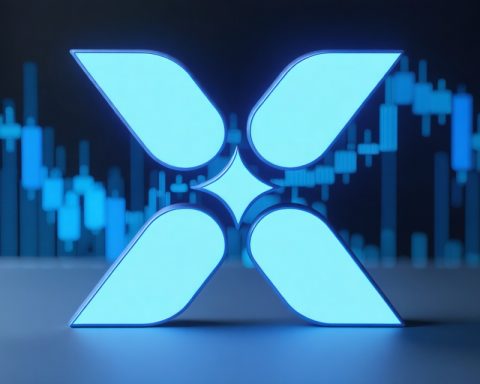- The electric vehicle market is seeing intense competition between Tesla and newcomer Rivian, each offering distinct advantages.
- Tesla holds 18% of the battery EV market and is exploring new ventures like the Robotaxi service despite facing financial fluctuations.
- Rivian attracts attention with innovative electric trucks and SUVs, backed by major investors, and is looking to release an affordable SUV by 2026.
- The EV market is projected to grow over 30% annually until 2030, making Tesla and Rivian attractive yet distinct investment opportunities.
- Investors face a decision between Tesla’s established path and infrastructure versus Rivian’s fresh innovation and design.
The electric vehicle market is electrifying the future of transportation, with industry titan Tesla and ambitious newcomer Rivian sparking a rivalry that has investors buzzing. Each company offers a unique journey into the rapidly evolving world of EVs, giving consumers an electrifying choice between tried-and-true reliability and fresh innovation.
Tesla reigns with a commanding 18% market share in battery EVs, its legacy resisting the pressures of rising material costs and global shortages. As it cruises into uncharted territories like the anticipated Robotaxi service, Tesla’s adaptability keeps it ahead. This pioneering service promises to disrupt urban mobility with autonomous rides, though recent mixed financial results have added a slight bump in the road.
On the other side of the spectrum, Rivian takes the adventurous path with its lineup of cutting-edge electric trucks and SUVs. It’s a rising star with high owner satisfaction and backing from giants like Volkswagen and Amazon, indicating a solid foundation amidst production setbacks. With plans for an affordable R2 SUV by 2026, Rivian is making its moves toward mainstream allure.
In a market expected to grow over 30% annually until 2030, choosing between these two powerhouses depends on what fuels your investment dreams. Tesla offers a road paved with experience and a robust charging network, albeit with aging models. Rivian promises innovation, adventurous design, and potential upsides, though not without its risks.
Whether you seek the steadfast path with Tesla or dive into Rivian’s daring future, the choice steers your portfolio into the vanguard of sustainable transport. Here’s your chance to ride the wave of transformation!
Electric Showdown: Tesla vs. Rivian – What You Need to Know Before Choosing Your EV Investment
Pros and Cons: Tesla vs. Rivian
Tesla Pros:
– Extensive Charging Network: Tesla’s Supercharger network is unmatched in terms of global reach and speed, providing convenience for long-distance travel.
– Autonomous Driving: Tesla’s autopilot and forthcoming Robotaxi service could revolutionize urban transport.
– Brand Recognition: As a market leader, Tesla has strong brand loyalty and recognition worldwide.
Tesla Cons:
– Aging Models: Despite innovation, some Tesla models are becoming outdated in design compared to newer competitors.
– Mixed Financial Results: Recent financial volatility may pose a risk to potential investors.
Rivian Pros:
– Unique Product Offering: Rivian focuses on electric trucks and SUVs, carving out a unique market niche.
– High Customer Satisfaction: Backing from Volkswagen and Amazon suggests optimism amongst investors regarding Rivian’s product lineup.
Rivian Cons:
– Production Challenges: Ongoing production setbacks may affect delivery timelines and financial performance.
– Market Entry Risk: As a newcomer, Rivian still faces high hurdles in scaling its operations and establishing a lasting market presence.
Innovations: What Sets Each Apart?
Both Tesla and Rivian are introducing groundbreaking innovations. Tesla’s upcoming Robotaxi service promises to challenge conventional urban transport systems, bringing driverless taxis into the mainstream. Rivian’s forthcoming R2 SUV aims to democratize advanced EV technology with a more affordable price point, slated for 2026. This move could redefine accessibility for electric adventure vehicles.
Market Analysis: Future Outlook for EV Giants
The electric vehicle market is projected to grow over 30% annually until 2030. This expansion presents vast opportunities for both Tesla and Rivian. Tesla’s established market presence could help it maintain its lead, but Rivian’s focus on a different vehicle category may draw in a separate consumer base seeking rugged, adventurous alternatives.
Important Questions Answered
1. What are the key differences in vehicle offerings between Tesla and Rivian?
Tesla’s lineup primarily consists of sedans, SUVs, and its anticipated Cybertruck, while Rivian focuses on EV trucks and SUVs, targeting adventure-seekers. This niche differentiation could help Rivian attract a distinct audience that values performance in off-road and higher utility aspects.
2. How are Tesla and Rivian addressing sustainability in their operations?
Tesla continues to prioritize sustainability through renewable energy solutions, including solar power for charging stations and battery recycling initiatives. Meanwhile, Rivian emphasizes sustainable materials and aims to offset its environmental impact by investing in carbon credits and other eco-friendly practices.
3. Which company presents a better investment opportunity given current market trends?
While both companies have significant growth potential, Tesla’s established infrastructure and continuous innovation could present a more secure investment. However, Rivian’s focus on market segments not yet fully explored may offer high-risk, high-reward scenarios for investors who believe in their long-term strategy.
For more detailed insights, consider exploring these credible domains:
Tesla
Rivian








